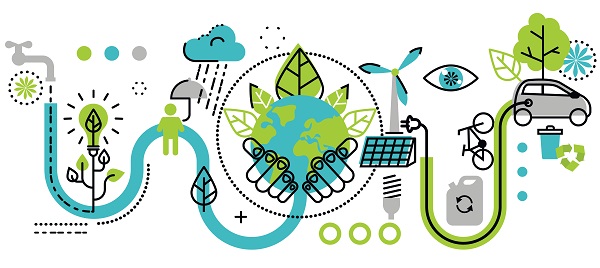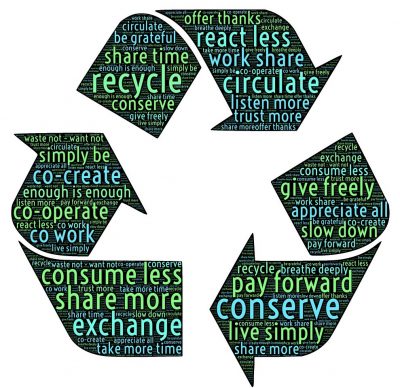
As we enter a new year, let’s take this opportunity to reflect on our daily habits and how we can live more sustainably. Every day we make choices in our lives that affect the environment, the climate, and other species. From our shopping choices to the mode of transportation, there’s a lot we can do to reduce our environmental footprint. Here’s a list of 9 sustainable resolutions you can make in your life to better the planet. Are you already doing some of these? If so, keep going! Perhaps there are some things on the list you do sometimes but could do with improvement.
1) Reduce, Reuse, Recycle!
You have probably heard this phrase a million times but it’s just as important today as when the phrase was first used. Every product we purchase has an environmental footprint, from the materials used to create it, to the pollution emitted during manufacturing, to the packaging that ends up in landfills. So before you buy, ask yourself if you really need it. If you do, consider buying gently used instead of new, and look for minimal packaging and shipping.
2) Say Goodbye to Plastic
Every year, billions of pounds of plastic end up in the world’s oceans and now make up about 40% of the world’s ocean surfaces. Plastic is so durable that the EPA reports “every bit of plastic ever made still exists.” Plastic pollution is killing thousands of seabirds, sea turtles, seals, and other marine mammals. To do your part in reducing global plastic waste, here are a few simple steps you can take:
- Always bring reusable bags when you shop
- Say no to plastic straws and bring your own reusable stainless-steel straw wherever you go
- Stop buying one-time-use water bottles
- Avoid products made from or packaged in plastic whenever possible (e.g. select unwrapped produce at the grocery store, shop local, etc.)
3) Don’t Buy “Fast Fashion”
Many major clothing retailers practice what is known as “fast fashion” by selling an endless cycle of must-have trends at extremely low prices. These same must-have trends end up in the landfill within the year or so, often to justify buying the latest styles. Did you know there are over 15 million tons of textile waste? By prioritizing mass production over quality, fast-fashion retailers can charge next to nothing for their items. This explains how it’s possible for you to pay only $5 for a t-shirt. And to make things worse, fast fashion is an industry still largely propped up by child labor. Toxic to the environment, detrimental to human rights – who needs it? Try alternatives like re-purposing old clothing, choosing locally / ethically made garments, or participating in clothing swaps with family and friends.
4) Use Water Wisely
Water conservation is critical, especially as our growing population puts increased demand on global water sources and unprecedented droughts are occurring around the world. Here are a few simple ways to conserve water:
- Take shorter showers
- Fix leaky toilets
- Choose low-flow and low-water appliance options
- Consider xeriscaping your yard which is a landscaping technique that uses native, drought-adapted plants that require less water and maintenance over time, and provide habitat and food for birds and bees.
5) Eat Local and Organic
Whenever possible, try to eat local and in-season produce. Sticking to foods that are grown locally, in your own city or the surrounding area, helps to reduce the carbon footprint created by shipping food from elsewhere. When a fruit or vegetable can be grown in your own backyard or a local farm, the environmental cost is significantly reduced. Just imagine the journey that food from a distant country has to take by plane, ship, train, or truck, and then the product must stay cool, so it doesn’t spoil. Small farms are also more likely to adopt beneficial soil-care practices and maintain borders for local wildlife. Eating locally-grown food supports your local economy and promotes food security. It’s equally important to eat organic produce, which hasn’t been sprayed with toxic pesticides and other environmentally detrimental chemicals. Choose whole foods that are better for the planet, and better for your own longevity!
6) Join a Local Co-op
Co-operatives exist in every part of the economy, as well as the not-for-profit sector, and provide many of our essential social services. Co-operatives are member-owned and controlled enterprises that are created to meet a common need. By joining a local co-op, you will be able to participate in and benefit from your local economy. If you are passionate about a specific local cause or initiative, your voice will be heard in a co-op that shares your values. Or if you’re looking to purchase local products and services, there are many local co-ops in your area who can meet those needs.
7) Drive Less, Drive Green
Changing your driving habits can dramatically reduce your carbon footprint. Walk, bike, carpool, or use public transportation whenever possible. You could combine errands to make fewer trips. It’s also important to keep your car in shape with regular tune-ups and tire inflations to increase your fuel efficiency. To significantly reduce your carbon footprint, you might want to also consider switching to a hybrid or electric vehicle. Here some of the many benefits of driving an electric vehicle:
- Lower “fuel” costs – The electricity to charge an EV works out to be around a third as much per kilometer as buying gas for the same vehicle
- Cheaper to maintain – There are relatively little servicing and no expensive exhaust systems, starter motors, fuel injection systems, radiators and many other parts that aren’t needed in an EV
- Better for the environment and less pollution – By choosing to drive an EV, you are helping to reduce harmful air pollution from exhaust emissions since an EV has zero exhaust emissions. Also, if you use solar power to recharge your EV, you can reduce your greenhouse gas emissions even further.
8) Make Your Home More Energy Efficient
Just as keeping your car in shape improves your fuel efficiency, keeping your home in shape improves your energy efficiency. Here are some ways to make your home more energy-efficient:
- Make sure your home has adequate insulation and energy-saving windows
- Use a programmable thermostat (like Nest) for more efficient heating and cooling
- Use energy-saving lightbulbs for more efficient lighting
- Unplug unused devices and chargers to reduce your electricity usage
- Avoid running your washer with hot water and opt for cold or warm water when possible
- Save on the cost of these upgrades by signing up for energy efficiency rebates and incentives in your area
9) Switch to Solar
Solar power just makes good sense. It’s very simple to generate solar power to offset your electricity use from the grid as Western Canada has one of the best solar potentials in Canada! Not only can you power your home or business but excess electricity produced can be exported to the grid where you receive a credit against future use. You’re already paying for an electricity bill, why not convert it into a solar investment that actually provides a return? This is your chance to protect yourself from rising utility costs while protecting the environment for future generations. With incentives available, now is the time to invest in a residential or commercial solar PV system.
If you are interested in installing a solar PV system for your home, farm, or business, please contact us for a free consultation. Take advantage of available incentives and begin harnessing your own solar power as soon as possible!
A solar specialist will contact you upon receipt of your request.


